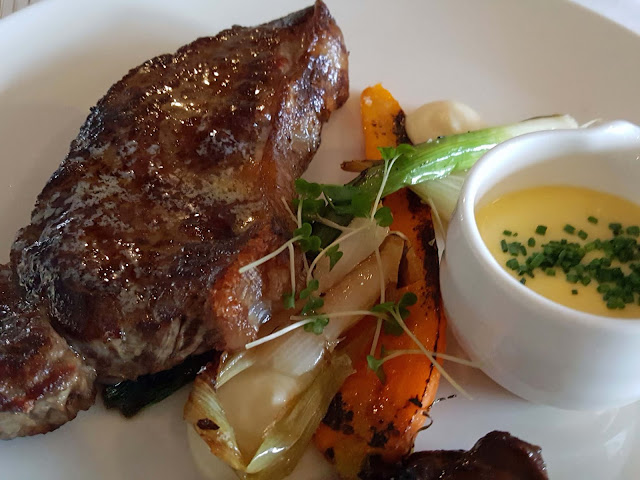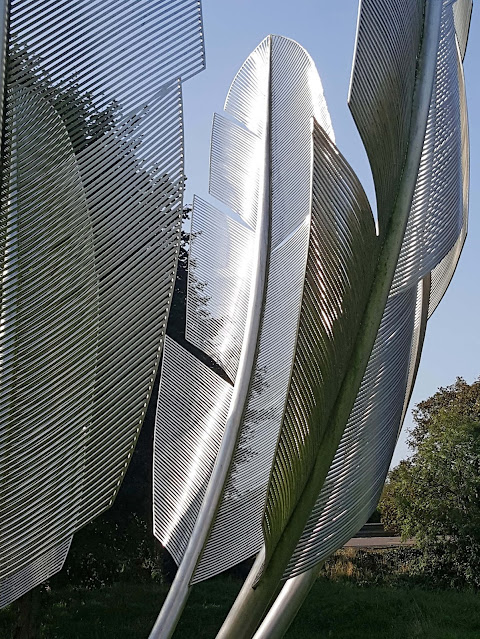A Quart of Ale± #14
Moving on over to craft.
The Non Alcoholic Alternative
Weihenstephaner “Original Helles” <0,5% abv, 0.5l bottle Bradley’s of Cork
“Our Original Helles – even without alcohol, it is refreshing and enjoyable.” That’s what they say and I’d have to agree. Bright gold colour, fountains of rapidly rising bubbles. Fluffy white head, in no rush to fade away. Slightly hoppy notes, slight spice also, introduce this thirst quencher. Light and crisp with excellent full flavour. Not quite all-out lip-smacking but pleasantly refreshing for sure with a mild bitterness and a clean dry finish. That the bitterness is mild is confirmed by the IBU number of 20.
Germany breweries regularly suggest food pairings and here Weihenstephaner, the world’s oldest brewery, provide the full recipe for Swiss Wurstsalat (Sausage Salad). All the details here.
They say: Our bright sunny-yellow alcohol-free lager “Original” with minerals, vitamins and micronutrients is an isotonic, low-calorie alternative to our lager and also a thirst quencher for active people. The pleasant spicy hops note and the full light and sweet flavor, with a slight bitterness, makes it an ideal companion for snacks, hearty salads or simply a refreshment on hot days. Brewed according to our centuries-old brewing tradition on the Weihenstephan hill.
Almost a thousand years ago the Bavarian State Brewery Weihenstephan was the monastery brewery of the Benedictine monks. Then, the Royal Bavarian State Brewery stepped in and it is now operating as a state directed enterprise under the control of the Bavarian Government.
To Øl “Implosion” 0.3%, 33cl can Bradley’s of Cork
This Danish ale is a pale and hazy yellow. Citrus in the delicate aromas. No explosion of flavours on the crisp palate but quite a pleasant balance and a good dry refreshing finish. May not be quite perfect but is one of the better non alcoholic beers. And the Danish brewery isn’t finished with the style yet: “You'll love where this non-ABV craft train is headed, I promise.” These brewers have a habit of living up to their promises!
The hop varieties used are Hallertau Blanc, Citra, Tettnanger and Mosaic, promising fruity and floral flavours. But it is the yeast that’s key here; it doesn’t produce alcohol though it does leave a little more sweetness than usual.
They say: It is light and chuggable, with nice peachy notes from the yeast. Slightly sweet, but not too prominent, nice and fresh hop aromas, and absolutely NO hangover! Alcohol-free beer as it should be.
I caught a recent Facebook post by the makers, sympathising with all of us who have tried some of those awful non-alcoholic drinks over the years.”You tried that beer in the bar years ago, against your better judgement - and it tasted like awful, sparkly bread water. You were horrified. Scarred for life. You swore to stick to the strong stuff, where it was safe. But, my friend, times - they are a-changing.”
.
So they threw out the rule book with this non-alcoholic Implosion beer. “We used a yeast that, when it ferments, doesn't create alcohol but still gives off amazing, ale esters. We then added hops to create a delicate, aromatic profile - and therefore didn't need to boil off the beer at the end of the process and risk losing all those amazing flavours.”
Brooklyn Hoppy Lager “Special Effects” 0,4% abv, 355ml bottle Bradley’s of Cork
Quite a warm amber colour, essentially clear. Must admit I didn’t get on at all with this one. Must try another bottle sometime, to be fair. If you had one of these as part of a session involving regular alcoholic ales, it might well pass. A bit disappointed with the Special Effects. Doesn’t have second glass appeal for me, though my drinking partner enjoyed it.
They say: Special Effects is a hoppy lager with an unexpected piney aroma and pleasantly bitter finish. It tastes like a regular beer but therein lies the special effect. It’s only 0.4% abv
Brooklyn Special Effects tastes just like a regular beer, but therein lies the special effect. We use a special fermentation method that develops the flavors, aromas & character of beer with none of the alcohol, and a generous dry hopping resulting in lively hop notes and a clean finish.
They have quite a long recommended food list: Spinach Salad, Grilled Chicken, Omelettes, BLT sandwiches, Toast Skagen (Brooklyn do have breweries in Scandinavia), Hot Wings, Working Lunches (it’s not a saison though), Weeknights, Fresh Goats Cheese (Ardsallagh, I reckon, rather than Shepherds Store).
Irish Contenders
Wicklow Wolf “Moonlight” Hoppy Ale 0.5%, 330ml can Supervalu
Brewed with speciality malts, this Wicklow Wolf states a claim to a high ranking among Irish non-alcoholic beers. Nice gold colour with a short-lived head. Citrus aromas in the hoppy head, hoppy all through really, well flavoured and an excellent fruity finish. One of the better ones for sure, neck and neck with the Dungarvan entry below, maybe marginally ahead.
Hops: Cascade, Hallertau Blanc, Citra
Malt: Melano, Cara Gold
IBU: 20
Dungarvan “Main Sail” <0,5% abv, 500ml bottle Bradley’s of Cork
Ireland’s first micro-brewed alcohol free beer has a gold colour, a white fluffy head with little staying power. Hoppy aromas are followed by a stiff backbone of the same on the palate where notes of citrus also show, all before a lingering bitter finish. Ireland’s first and one of the better ones.
They say: Our head brewer, Cormac O’Dwyer, believes that it takes quality ingredients, time, care and attention to detail to create the perfect brews and this is the methodology that he employs when brewing our Dungarvan beer.All the beers are traditionally brewed and bottled on-site in Dungarvan, Co. Waterford made using only four ingredients – barley, hops, yeast and water. No chemicals are added to the beers, they are unfiltered, unpasteurised and vegan-friendly.
Hops used for Mainsail: Amarillo, Challenger
Malts: Munich, Caramalt, Crystal Malt, Cararoma
And where did the name come from? From the Pogues’ “When The Ship Comes in”
A song will lift
As the mainsail shifts
And the boat drifts on to the shoreline
Kinnegar “Low Tide” Pale Ale 0.5%, 44cl can O’Briens
This aptly-named Low Tide from Kinnegar is a mid-gold, with a close to clear, white head that slowly fades away. Aromas feature hops. Indeed, it’s moderately hoppy all the way through. Don’t think I’d stick with this for a session but it could come in handy if taking it easy for a night, one Limeburner, one Low Tide and repeat!
They say: Low Tide is our traditionally brewed zero-point-five per cent pale ale, created to make life with less alcohol enjoyable, even for beer lovers.





















































